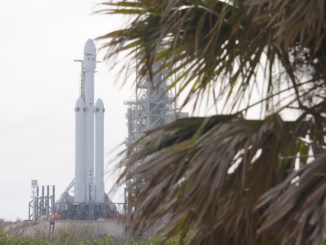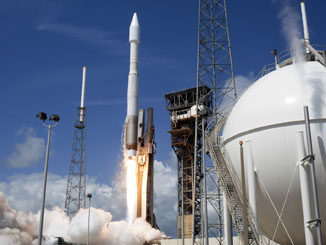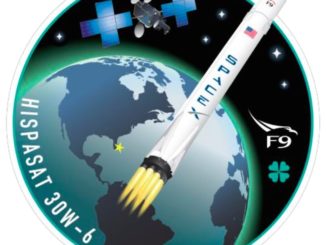
On its third flight Monday night, SpaceX’s Falcon Heavy rocket will fly to three different orbits with two dozen spacecraft on a mission set to last more than six hours, prompting SpaceX founder Elon Musk to declare it the company’s “most difficult launch ever.”
The triple-core rocket, made by combining three Falcon 9 boosters on a single launcher, is set for liftoff from pad 39A at NASA’s Kennedy Space Center in Florida during a four-hour launch window opening at 11:30 p.m. EDT Monday (0330 GMT Tuesday).
There is a 70 percent chance of favorable weather during the overnight launch window, which officials selected to satisfy the payloads’ thermal requirements on their ride into orbit.
It will be the first night launch by SpaceX’s Falcon Heavy, the world’s most powerful rocket currently in service. The rocket’s 27 Merlin main engines will drive the rocket off the ground with 5.1 million pounds of thrust, nearly twice the thrust of any other operational launch vehicle.
What’s more, the rocket’s two side boosters will come back to Cape Canaveral minutes after liftoff. The fiery night launch and landings, coupled with the roar from the Falcon Heavy’s 27 main engines and crackling sonic booms upon return of the boosters, will be a can’t-miss spectacle for space enthusiasts and local residents, weather permitting.
SpaceX completed a pre-launch engine test-firing Wednesday night at pad 39A, then returned the rocket to its hangar Friday to receive its 24 satellite payloads. The research and weather observation satellites come from the U.S. Air Force, NASA, NOAA, universities, international partners and non-profit organizations.
The Air Force is overseeing the launch through the Defense Department’s Space Test Program, a unit that arranges rides to space for the military’s experimental satellites.
The mission is designated STP-2.
“STP-2 is the government’s first launch on a SpaceX Falcon Heavy vehicle, and is one of the most challenging missions the Space and Missile Systems Center has ever launched,” said Col. Robert Bongiovi, director of the launch enterprise systems directorate at SMC. “We’re putting 24 research and development satellites into three separate orbits, with a first-ever four engine start and burn of the second stage.”
Elon Musk, SpaceX’s founder and CEO, agrees, calling the STP-2 mission SpaceX’s “most difficult launch ever.”
“Every launch is kind of unique, and this one’s definitely unique since there are so many deployments in many different orbits,” said Mike Marlow, the STP-2 mission manager from the Space Test Program at Kirtland Air Force Base, New Mexico.
SpaceX has never fired an upper stage engine more than three times in space as part of a rocket’s primary mission.
The STP-2 mission has a total financial value of about $750 million, including the satellites and the SpaceX launch service procured by the Air Force, according to Marlow. That’s a rough estimate, however, because the satellites come from multiple government and international institutions who track finances in different ways.
Falcon Heavy to launch into three distinct orbits
Over the weekend, SpaceX workers were removing a test version of the Falcon Heavy’s payload fairing, which was installed to gather acoustic data during the static fire test. The mission’s satellite payloads, already encapsulated inside a flight-worthy fairing, were set to be mated to the Falcon Heavy ground crews return the rocket to pad 39A ahead of Monday night’s launch.
After riding a transporter up the ramp to pad 39A, the Falcon Heavy will be raised vertical for final countdown preparations and fueling Monday evening.
A computer-controlled countdown sequencer will oversee the loading nearly 3 million pounds of super-chilled kerosene and liquid oxygen into the Falcon Heavy’s three first stage boosters and upper stage.
Following final steering checks and pressurization of the rocket’s propellant tanks, computers will give the command for the Falcon Heavy to ignite its engines in the final 10 seconds of the countdown. Hold-down clamps at the base of the rocket will release to allow the Falcon Heavy to climb into the sky.
Turning due east from Florida’s Space Coast, the Falcon Heavy will arc downrange over the Atlantic Ocean and exceed the speed of sound in about one minute.
Around two-and-a-half minutes into the launch, the side boosters will shut down and separate from the Falcon Heavy’s center core to begin a series of propulsive maneuvers guiding the twin rockets back to Landing Zone 1 and Landing Zone 2 at Cape Canaveral Air Force Station.
Coming back from the edge of space, the rockets will target nearly simultaneous touchdowns at the landing site, around 9 miles (15 kilometers) south of pad 39A.
Monday night’s mission will be the first time SpaceX has landed two rocket boosters at the same time at night. The side boosters both flew on the previous Falcon Heavy mission with the Arabsat 6A commercial communications satellite April 11, when they landed back at Cape Canaveral.
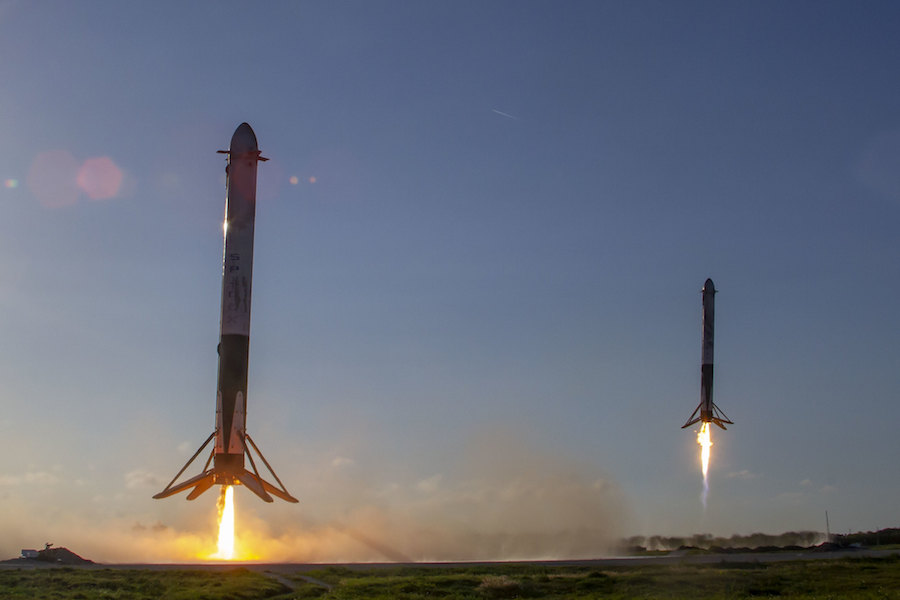
“As long as there are no clouds, but having been down there for a couple, the recoveries back on land, they do end up being a spectacular sight coming back to the landing zone,” said Walter Lauderdale, the STP-2 mission director from SMC’s Falcon systems and operations division.
After release of the side boosters, the Falcon Heavy’s center core will throttle up its engines to full power. The core stage will operate at partial power for the first couple of minutes of the mission to conserve fuel.
Around three-and-a-half minutes after liftoff, the core stage will turn off its engines and separate to begin its own controlled descent to SpaceX’s offshore drone ship positioned nearly 770 miles (1,240 kilometers) east of Cape Canaveral. The recovery vessel is parked farther downrange than for any previous SpaceX mission, and the Falcon Heavy’s core stage will come down faster than any booster before.
The core stage will aim for landing on the drone ship around 10 minutes into the mission, shortly after the touchdown of the Falcon Heavy’s side boosters. The core stage flying Monday night is a new booster.
The core stage from the inaugural Falcon Heavy launch in February 2018 crashed on landing, and the center booster from the second Falcon Heavy mission in April made a successful touchdown, but tipped over before it could be secured for return to port.
But the mission will just be beginning by the time the Falcon Heavy’s three boosters make it back to Earth.
The rocket’s second stage, powered by a single Merlin engine, will ignite four times on the lengthy flight.
The first burn will heave the mission’s 8,157-pound (3,700-kilogram) payload stack into low Earth orbit, where 13 satellites will deploy from adapters on the Falcon Heavy’s upper stage.
The first orbital target for the STP-2 mission ranges in altitude between about 186 miles (300 kilometers) and 534 miles (860 kilometers). The first orbit will have an inclination, or tilt, of 28.5 degrees to the equator.
The first of the payloads to release from the Falcon Heavy will be Oculus-ASR, a microsatellite developed by students at Michigan Technological University in partnership with the Air Force Research Laboratory. Oculus-ASR will test the ability of ground-based observers to determine the orientation and configuration of a satellite in orbit using unresolved imagery.
According to Marlow, Oculus-ASR will separate from the launcher around 13 minutes after liftoff, followed by the ejection of 12 CubeSats.
A second firing by the Falcon Heavy’s upper stage engine will steer the rocket into a circular orbit around 447 miles (720 kilometers) above Earth, with an inclination at 24 degrees, closer to the equator.
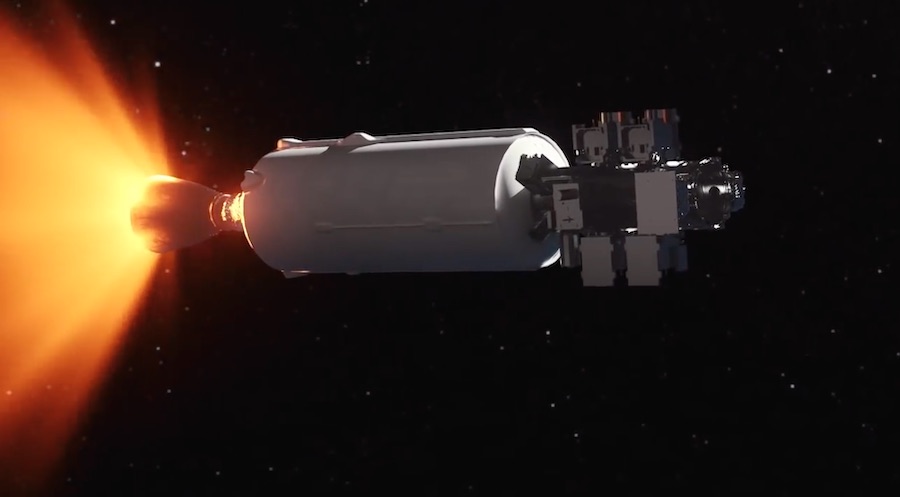
Six weather satellites developed by NOAA and Taiwan’s space agency will separate from the launcher in the 447-mile-high orbit, along with several other microsatellites.
The Constellation Observing System for Meteorology, Ionosphere, and Climate-2, or COSMIC-2, mission will form a weather observation network collecting data on temperature, pressure, density and water vapor at various layers in Earth’s atmosphere.
Other satellites set for deployment on the mission’s second orbit include the Orbital Test Bed spacecraft built by General Atomics. The Orbital Test Bed, or OTB, mission hosts several payloads, including the Deep Space Atomic Clock experiment from NASA, which will test a new type of hyper-accurate atomic clock that could make it easier for deep space probes to navigate.
Another package attached to the OTB satellite carries the cremated remains of 152 people, including the late astronaut Bill Pogue and space journalist and historian Frank Sietzen. The payload, called “Heritage Flight” and arranged by Celestis, will remain in orbit with the OTB spaceraft for around 25 years.
NASA’s Green Propellant Infusion Mission is also timed to deploy in the 447-mile orbit. Built by Ball Aerospace with a propulsion system from Aerojet Rocketdyne, the mission will test a new type of non-toxic “green” propellant that could be used on future satellites to replace hydrazine, a caustic fuel commonly used on spacecraft because it can be stored for years at room temperature.
A satellite named NPSAT 1 developed at the Naval Postgraduate School will also separate in the Falcon Heavy’s second orbit. NPSAT 1 carries two instruments from the Naval Research Laboratory to measure electron cloud densities in Earth’s ionosphere, a layer high above Earth that affects long-range radio communications. Engineers will also use the microsatellite to test a radiation-tolerant computer processor, experimental solar cells, and low-cost memory devices, rate sensors and a commercial digital camera.
Georgia Tech’s suitcase-sized Prox-1 microsatellite is the other satellite slated for deployment in the STP-2 mission’s second orbit. Prox-1, also funded through an Air Force Research Laboratory grant, will test proximity operations and in-orbit inspection techniques after releasing a daughter satellite named LightSail 2, a crowd-funded CubeSat from the Planetary Society designed to demonstrate the propulsion capability of a solar sail, which harnesses pressure from sunlight for thrust.
After dropping dropping off the microsatellites, the Falcon Heavy’s upper stage will reignite two more times to reach a higher altitude and higher inclination for deployment of the final payload — the Air Force Research Laboratory’s Demonstration and Science Experiments, or DSX, spacecraft.
The DSX satellite will fly in a slot region between the Van Allen radiation belts with instruments to measure the effects of very low frequency radio waves on space radiation, space weather conditions and the impact of radiation on electronics and spacecraft materials.
“The space domain has never been more important to our nation than it is today,” said Maj. Gen. William Cooley, commander of the Air Force Research Laboratory. “The DSX satellite experiment will greatly increase our understanding of the environment spacecraft operate in and will give us the knowledge to build even better satellites to protect and defend our space assets. I am immensely proud of the AFRL scientists, engineers, and technicians that conceived and built the DSX satellite.”
DSX will circle the Earth in a unique orbit between 3,728 miles (6,000 kilometers) and 7,456 miles (12,000 kilometers) in altitude, with an inclination of 42 degrees to the equator. DSX is the heaviest single spacecraft on the STP-2 mission, with a launch weight of roughly 1,540 pounds, or about 700 kilograms, according to Marlow.
A suite of NASA experiments is riding on the DSX satellite to allow scientists to measure how radiation can corrupt spacecraft memory devices and damage electrical circuits.
With DSX away from the rocket, the Falcon Heavy’s upper stage will be “passivated,” or put into a safe configuration, by dumping the rocket’s leftover propellant overboard. The passivation will mark the end of the STP-2 launch sequence, which SpaceX and the Air Force say will last six-to-seven hours from start to finish.
STP-2 maximizes Falcon Heavy’s lift capacity, paves the way for more military launches
The mission will exercise the Falcon Heavy to its limits, allowing SpaceX and the Air Force to collect data to ensure the rocket is ready to lift the military’s most expensive national security payloads into orbit.
“Volume-wise, the payloads take up about a third, maybe a little more than a third, of their payload fairing,” Marlow said. “But performance-wise, because we’re going to three different orbits, it takes up all of the Falcon Heavy’s performance, actually.”
“They’re returning all three boosters,” Bongiovi said. “That takes some of the performance of the rocket to do that. You reduce the amount of payload you can technically launch by doing that. Same thing with the orbital changes we’re doing, the four burns and how we’re putting these satellites in different orbits, that affects the amount of mass that can go to each of those orbits.”
“Even though the first orbit is a parking orbit, you still have to sit there and pause while you deploy all of the satellites, and then start the second stage again to go to the next orbit,” Marlow said.
“All of that timing that it takes also eats into the performance of the launch vehicle because things are getting colder on orbit,” he said. “There are a lot of parameters that really go into the entire performance calculation. This entire mission is more than seven hours long, so that’s actually a long time for a launch vehicle to be operating in orbit.”
The satellites on-board the STP-2 mission, while unique and valuable, are all experimental. The Air Force holds launch vehicles assigned to carry operational reconnaissance, communications and navigation payloads to a higher standard.
The Air Force announced the Falcon Heavy was certified after its inaugural flight last year, making it eligible to win contracts to launch the military’s most critical operational satellites. The Air Force signed the contract for the STP-2 mission with SpaceX in December 2012 as a purely experimental mission.
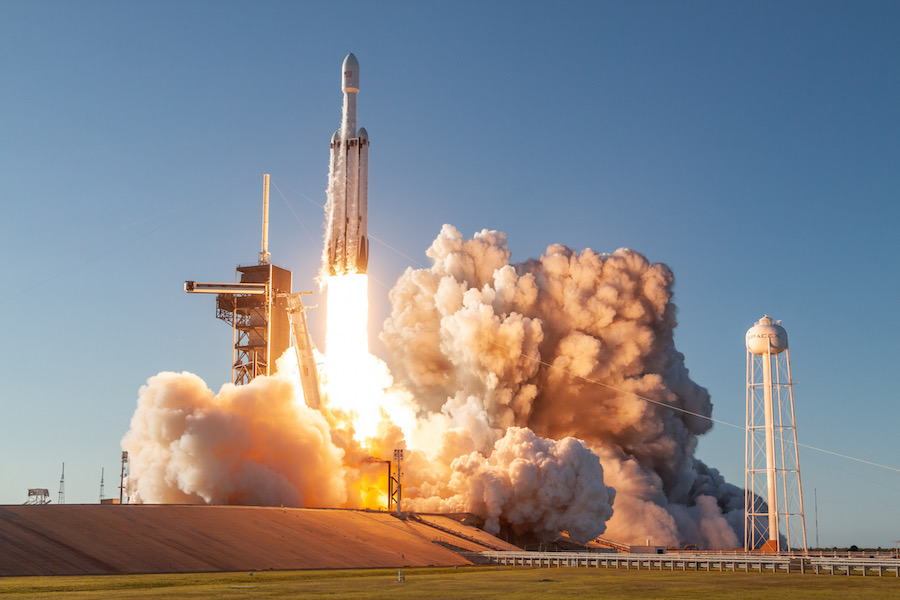
Since last year’s certification milestone, the Air Force has awarded SpaceX two launch contracts for missions codenamed AFSPC-44 and AFSPC-52, which are scheduled for launch from NASA’s Kennedy Space Center in late 2020 and early 2021.
The STP-2 mission will now be the third certification flight for the Falcon Heavy as the Air Force prepares to entrust the launcher with more important payloads.
“What we’re doing now is what we call the spaceflight worthiness process,” Bongiovi said.
“This launch, STP-2, is the third certification flight. It’s one of many sets of data and reviews that we do with SpaceX and any contractor that we’re certifying for (and) doing non-recurring design and validation on … to get to the point where (we) can certify that that launch vehicle is ready to launch the critical national security payloads that we’ll be launching on those two missions,” Bongiovi said.
The Air Force will also use the experience gained from the STP-2 mission to help certify reused rocket hardware for national security missions. The Air Force’s launches with SpaceX, to date, have all used newly-built Falcon 9 boosters.
“The launch was originally just an opportunity to characterize the launch vehicle for future use by the National Security Space Launch program, but now it is the Air Force’s first launch using previously-flown rocket hardware,” Bongiovi said.
SpaceX has re-flown a Falcon booster 22 times since March 2017, all successfully.
“The use of the previously-flown hardware is providing critical insight into reusability and quality assurance that will allow us to provide space access to the warfighter in a more cost-effective and expedient manner, and I really appreciate the efforts of our industry partner SpaceX to make this happen,” Bongiovi said.
In the AFSPC-52 launch contract announced last year, the Air Force agreed to pay SpaceX $130 million for a Falcon Heavy mission. The Delta 4-Heavy rocket, the biggest vehicle the fleet of SpaceX rival United Launch Alliance, sells for about $300 million per flight.
If SpaceX convinces the Air Force to certify reused rockets for national security missions, the price of a Falcon Heavy mission could further fall.
“The reason that we’re excited about this, and about having previously-flown hardware on (STP-2) is that we’ve been able to fo follow along as we’ve done recovery and refurbishment of those boosters.
“For the past few years, we have been working pretty hard on the government mission assurance efforts that we do to make sure that we have the success record. We’ve had 76 successes in a row,” Bongiovi said, referring to the Air Force’s national security launch division, formerly called the EELV program, which primarily has used ULA’s Atlas and Delta rockets to achieve that success record. “Sometimes it’s better to go off and do, than just to write the procedures.”
The STP-2 mission was originally supposed to launch with all-new boosters, but the Air Force and SpaceX agreed late last year to change plans and fly reused side boosters.
STP-2 was supposed to launch on the second Falcon Heavy mission, but the contract modification pushed the STP-2 launch behind the launch of the Arabsat 6A telecom satellite in SpaceX’s queue.
The boosters from the Arabsat 6A mission are among the most “gently-used” in SpaceX’s inventory, Air Force officials said. They encountered relatively benign aerodynamic forces and structural loads on their descent back to Florida’s Space Coast in April.
The Air Force’s launch contract with SpaceX for the STP-2 mission was previously valued at $185 million, according to Lt. Col. Ryan Rose, chief of the small launch and targets division at Kirtland Air Force Base.
The launch is now costing the Air Force around $160 million, and a “big factor” in the cost reduction was the military’s agreement to fly the STP-2 mission with reused rocket boosters, Bongiovi said.
Email the author.
Follow Stephen Clark on Twitter: @StephenClark1.

